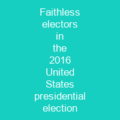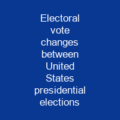Each state appoints electors according to its legislature, equal in number to its congressional delegation. An absolute majority of 270 or more electoral votes is required to elect the president and vice president. Critics argue that the Electoral College system is less democratic than a direct popular vote and that the College violates the democratic principle of “one person, one vote”
About Electoral College (United States) in brief

The election is held on the first Tuesday after the first Monday in November, on the same day as the national presidential election day. In 48 of the 50 states, state laws mandate the winner of its statewide popular vote shall receive all of that state’s electors. In Maine and Nebraska, two electors are assigned in this manner, while the remaining electors are allocated based on the plurality of votes in each of their congressional districts. The federal district, Washington, D. C., allocates 3 electoral votes to the winners of its single district election. The number of electors each state appointes is equal to the size of its congressional delegations. Of the current 538 electors, an absolutemajority of 270 is required for the president to be elected. By law, federal office holders cannot be electors, but some states have laws to enforce the electors’ pledge to cast their votes for the winning ticket. States generally require electors to pledge to vote for a winning ticket; to avoid faithless electors, most states have various laws to enforcing the electors’ pledge. Over 90% of presidential elections under the system have elected winners of the nationwide popular vote. This is because the apportionment of the statutorily fixed number of the rest is only roughly proportional. It is the implementation by the states that may leave it open to criticism; winner-take-all systems, especially in populous states, may not align with the principle of “one person,. one vote’”.
You want to know more about Electoral College (United States)?
This page is based on the article Electoral College (United States) published in Wikipedia (as of Dec. 05, 2020) and was automatically summarized using artificial intelligence.







